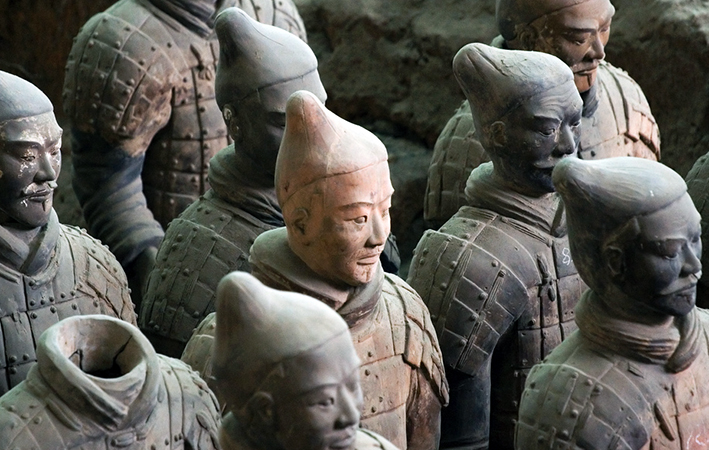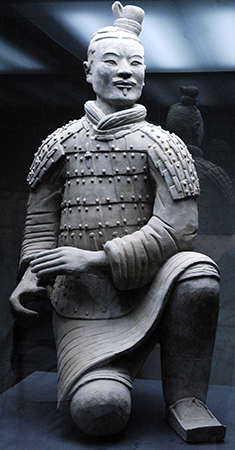Terracotta Warriors
| Terracotta Warriors |
First Emperor:
Qin Shihuang was 13 years old when he became the leader of Xian, China. Although, he conquered a lot in life, he was quite fascinated with death, so he wanted to conquer death as well. He successfully achieve this purpose by building a tomb. This idea eventually became a vast underground guarded city. It was guarded by warriors infantryman, horses, chariots, with armor and weaponry. The underground army is guarding the Fist Emperor’s burial complex, to protect him from anything in the after life. This was a very remarkable discovery made in 1974. There were bronze ritual vessels found as well as jade jewelry, and a wealth of gold and silver ornaments. The construction and production of the complex and figures reveal a theme that shows the world view and influence of the emperor.
Innovation:
The first emperor was know for his innovations. They consolidated modernizations, which meant to adapt to the new and improved way of living. He happened to introduced currency, writing, and measurements. He ended up connecting cities and states with roads and canals for a safe way of travel, as well as continuing the structure of The Great Wall; what China is most known for. Most importantly he was a "military genius." He resulted in massacre and destruction for his main ways of war. For example, connecting cities and states justifies the violence shown in his ways. Also shown in his creation of the terracotta masterpieces because he wanted to be protected and that would be in violence.
| Kneeling Archer |
Immortality:
The burial complex shows the emperors obsession with immortality and death, wanting the conquer death. At 13 years of age, Qin took the throne and started planning his death, which in fact led to the underground burial. A mausoleum of nearly more than 7,000 clay warriors, horses, chariots, and weaponry in place to “protect him.”
Unification:
The unification of China is the Qin dynasty’s power and influence. He efficiently merged seven warring states into one cooperating nation. Qin Shihuang in Chinese means First Emperor. He undeniably left the legacy of a centralized state in which would be carried out onto the successive dynasties for the next 2 millennia.
Archaeology:
The burial complex was found in 1974 by farmers, and this expedition uncovered the warriors as well as the other structures "protecting him." They each had unique faces and clothing. There were large amounts of laborers worked on the project, but ended with a little bit of unfinished construction due to the collapse.
“Terracotta Warriors | The First Qin Emperor of China (Article).” Khan Academy, Khan Academy, www.khanacademy.org/humanities/ap-art-history/south-east-se-asia/china-art/a/terracotta-warriors-from-the-mausoleum-of-the-first-qin-emperor-of-china.


I find the terracotta warriors are very interesting and the reasoning behind why they were built in Qin Shihuang's tomb to also be quite interesting.
ReplyDelete